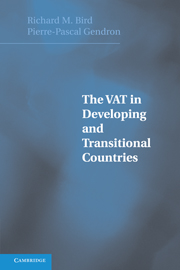Book contents
- Frontmatter
- Contents
- List of Tables
- Preface
- 1 Why This Book?
- 2 The Rise of VAT
- 3 Is VAT Always the Answer?
- 4 Trade and Revenue
- 5 Equity and the Informal Sector
- 6 What Should Be Taxed?
- 7 Key Issues in VAT Design
- 8 New Issues in VAT Design
- 9 Administering VAT
- 10 Dealing with Difficulties
- 11 The Political Economy of VAT
- 12 Where Do We Go from Here?
- Annex
- References
- Index
2 - The Rise of VAT
Published online by Cambridge University Press: 16 November 2009
- Frontmatter
- Contents
- List of Tables
- Preface
- 1 Why This Book?
- 2 The Rise of VAT
- 3 Is VAT Always the Answer?
- 4 Trade and Revenue
- 5 Equity and the Informal Sector
- 6 What Should Be Taxed?
- 7 Key Issues in VAT Design
- 8 New Issues in VAT Design
- 9 Administering VAT
- 10 Dealing with Difficulties
- 11 The Political Economy of VAT
- 12 Where Do We Go from Here?
- Annex
- References
- Index
Summary
In this chapter, we consider four simple questions. First, what exactly is a VAT? Second, which countries have VATs, and how important is VAT in these countries? Third, why has VAT spread around the world so quickly and so broadly? Fourth, is there one ‘VAT world’ or two?
WHAT IS A VAT?
What exactly is a VAT? A recent definitive statement defines a value-added tax as “a broad-based tax levied at multiple stages of production [and distribution] with – crucially – taxes on inputs credited against taxes on output. That is, while sellers are required to charge the tax on all their sales, they can also claim a credit for taxes that they have been charged on their inputs. The advantage is that revenue is secured by being collected throughout the process of production (unlike a retail sales tax) but without distorting production decisions (as a turnover tax does)” (International Tax Dialogue 2005, 8; emphasis omitted). The same name, however – whether value-added tax (VAT) or the more recently favored goods and services tax (GST) – may cover a variety of taxes in different countries. Like the personal income tax, a VAT is not so much a single tax as a set of taxes that share certain characteristics. To put the point in zoological terms, VAT is neither a gorilla nor a chimpanzee but rather a genus like ‘primates.
Information
- Type
- Chapter
- Information
- The VAT in Developing and Transitional Countries , pp. 10 - 27Publisher: Cambridge University PressPrint publication year: 2007
Accessibility standard: Unknown
Why this information is here
This section outlines the accessibility features of this content - including support for screen readers, full keyboard navigation and high-contrast display options. This may not be relevant for you.Accessibility Information
- 1
- Cited by
